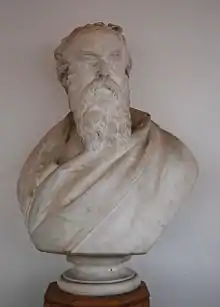Samuel Timmins
Samuel Timmins (27 February 1826 – 12 November 1902[1]) was a British Shakespearean scholar and antiquarian. He was invariably known as Sam Timmins, and signed himself "Sam: Timmins", using a colon for abbreviation in early modern style.[2]
Samuel Timmins | |
|---|---|
 Bust, by Francis John Williamson, in the Library of Birmingham | |
| Born | 1826 |
| Died | 12 November 1902 |
| Occupation | Shakespearean scholar and antiquarian |
He inherited a family business, founded in 1790 by his grandfather Richard Timmins, and based in Hurst Street, as a manufacturer of steel "toys" (i.e. small items such as hinges, buckles and hooks).[3] His true passion, however, was literature; and towards the end of his life he depended for his income as much on his literary output as on his business.[4]
In about 1858, Timmins, the nonconformist preacher George Dawson, J. T. Bunce, J. H. Chamberlain, William Harris, and others in their circle, began to meet for literary and cultural discussions. By 1860, these meetings had been regularised into a more formal club, which in 1862 was named "Our Shakespeare Club". H. R. G. Whates calls Our Shakespeare Club "the intellectual centre of the community, [and] the nineteenth century equivalent of the famous Lunar Society".[5][6] One of the principal achievements of the club, and of Timmins in particular, was the establishment of the Shakespeare Memorial Library within the Central Library in 1864 (the tercentenary year of Shakespeare's birth). The library included a portrait bust of Timmins by F. J. Williamson.[3] The original contents of this library were lost in a fire during 1879, when Timmins was seen sobbing at the destruction.[3] A new Shakespeare Library was created within the new Reference Library built in 1881, and a copy of the bust restored there.
Timmins died on 12 November 1902, aged 76, and was buried in Key Hill Cemetery, Hockley, Birmingham.[1][7]
References
- "Burial List: Key Hill and Warstone Lane". Jewellery Quarter Research Trust. Retrieved 21 October 2016.
- Whates 1957, p. 108.
- Roberts 2013.
- Whates 1957, pp. 108–9.
- Whates 1957, pp. 106–8.
- Harris, William (1903). The History of Our Shakespeare Club. Birmingham: Birmingham Journal.
- Manning, E. H. (1924) [1915]. Handbook of the Birmingham General Cemetery: together with biographical notes on those interred therein. Birmingham: Hudson & Son. p. 55.
Further reading
- Roberts, Stephen (2013) [2004]. "Timmins, Samuel (1826–1902)". Oxford Dictionary of National Biography (online ed.). Oxford University Press. doi:10.1093/ref:odnb/104869. (Subscription or UK public library membership required.)
- Whates, H. R. G. (1957). The Birmingham Post 1857–1957: a centenary retrospect. Birmingham: Birmingham Post & Mail Limited. pp. 108–9.
External links